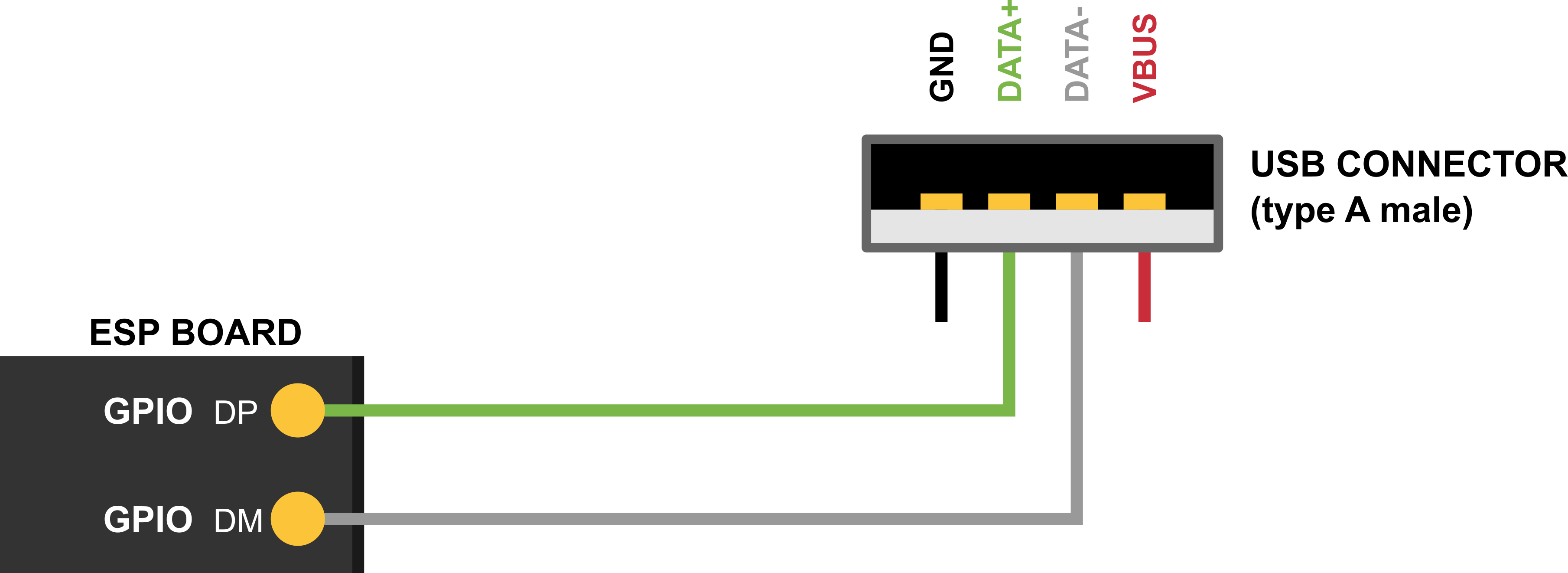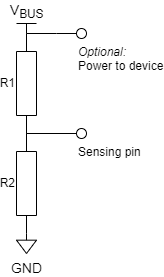USB Device Driver
Overview
The driver allows users to use ESP32-S2 chips to develop USB devices on a top of the TinyUSB stack. TinyUSB is integrated with ESP-IDF to provide USB features of the framework. Using this driver the chip works as a composite device supporting several USB devices simultaneously. Currently, only the Communications Device Class (CDC) type of the device with the Abstract Control Model (ACM) subclass and the Musical Instrument Digital Interface (MIDI) are supported.
TinyUSB stack is distributed via IDF Component Registry.
Our USB-OTG implementation is limited to 6 USB endpoints (5 IN/OUT endpoints and 1 IN endpoint) - find more information in technical reference manual.
Features
Configuration of device and string USB descriptors
USB Serial Device (CDC-ACM)
Input and output streams through USB Serial Device
Other USB classes (MIDI, MSC, HID…) support directly via TinyUSB
VBUS monitoring for self-powered devices
Hardware USB Connection
Any board with the ESP32-S2 chip with USB connectors or with exposed USB’s D+ and D- (DATA+/DATA-) pins.
If the board has no USB connector but has the pins, connect pins directly to the host (e.g. with do-it-yourself cable from any USB connection cable).
On ESP32-S2, connect GPIO 20 and 19 to D+/D- respectively:

Self-powered devices must also connect VBUS through voltage divider or comparator, more details in Self-Powered Device subchapter.
Driver Structure
As the basis is used the TinyUSB stack.
On top of it the driver implements:
Customization of USB descriptors
Serial device support
Redirecting of standard streams through the Serial device
Encapsulated driver’s task servicing the TinyUSB
Configuration
Via Menuconfig options you can specify:
Several of descriptor’s parameters (see: Descriptors Configuration bellow)
USB Serial low-level Configuration
The verbosity of the TinyUSB’s log
Disable the TinyUSB main task (for the custom implementation)
Descriptors Configuration
The driver’s descriptors are provided by the tinyusb_config_t structure’s descriptor and string_descriptor members. Therefore, users should initialize tinyusb_config_t to their desired descriptor before calling tinyusb_driver_install() to install driver.
However, the driver also provides a default descriptor. The driver can be installed with the default descriptor by setting the descriptor and string_descriptor members of tinyusb_config_t to NULL before calling tinyusb_driver_install(). The driver’s default descriptor is specified using Menuconfig, where the following fields should be configured:
PID
VID
bcdDevice
Manufacturer
Product name
Name of CDC device if it is On
Serial number
If you want to use your own descriptors with extended modification, you can define them during the driver installation process.
Install Driver
To initialize the driver, users should call tinyusb_driver_install(). The driver’s configuration is specified in a tinyusb_config_t structure that is passed as an argument to tinyusb_driver_install().
Note that the
tinyusb_config_tstructure can be zero initialized (e.g.tinyusb_config_t tusb_cfg = { 0 }) or partially (as shown below). For any member that is initialized to 0 or NULL, the driver will use its default configuration values for that member (see example below)
const tinyusb_config_t partial_init = {
.descriptor = NULL; //Uses default descriptor specified in Menuconfig
.string_descriptor = NULL; //Uses default string specified in Menuconfig
.external_phy = false;
};
Self-Powered Device
USB specification mandates self-powered devices to monitor voltage level on USB’s VBUS signal. As opposed to bus-powered devices, a self-powered device can be fully functional even without USB connection. The self-powered device detects connection and disconnection events by monitoring the VBUS voltage level. VBUS is considered valid if it rises above 4.75V and invalid if it falls below 4.35V.
No ESP32-S2 pin is 5V tolerant, so you must connect the VBUS to ESP32-S2 via a comparator with voltage thresholds as described above, or use a simple resistor voltage divider that will output (0.75 x Vdd) if VBUS is 4.4V (see figure below). In both cases, voltage on the sensing pin must be logic low within 3ms after the device is unplugged from USB host.

Simple voltage divider for VBUS monitoring
To use this feature, in tinyusb_config_t you must set self_powered to true and vbus_monitor_io to GPIO number that will be used for VBUS monitoring.
USB Serial Device (CDC-ACM)
If the CDC option is enabled in Menuconfig, the USB Serial Device could be initialized with tusb_cdc_acm_init() according to the settings from tinyusb_config_cdcacm_t (see example below).
tinyusb_config_cdcacm_t acm_cfg = {
.usb_dev = TINYUSB_USBDEV_0,
.cdc_port = TINYUSB_CDC_ACM_0,
.rx_unread_buf_sz = 64,
.callback_rx = NULL,
.callback_rx_wanted_char = NULL,
.callback_line_state_changed = NULL,
.callback_line_coding_changed = NULL
};
tusb_cdc_acm_init(&acm_cfg);
To specify callbacks you can either set the pointer to your tusb_cdcacm_callback_t function in the configuration structure or call tinyusb_cdcacm_register_callback() after initialization.
USB Serial Console
The driver allows to redirect all standard application streams (stdinm stdout, stderr) to the USB Serial Device and return them to UART using esp_tusb_init_console()/esp_tusb_deinit_console() functions.
Application Examples
The table below describes the code examples available in the directory peripherals/usb/.
Code Example |
Description |
|---|---|
How to set up ESP32-S2 chip to get log output via Serial Device connection |
|
How to set up ESP32-S2 chip to work as a USB Serial Device |
|
How to set up ESP32-S2 chip to work as a USB MIDI Device |
|
How to set up ESP32-S2 chip to work as a USB Human Interface Device |